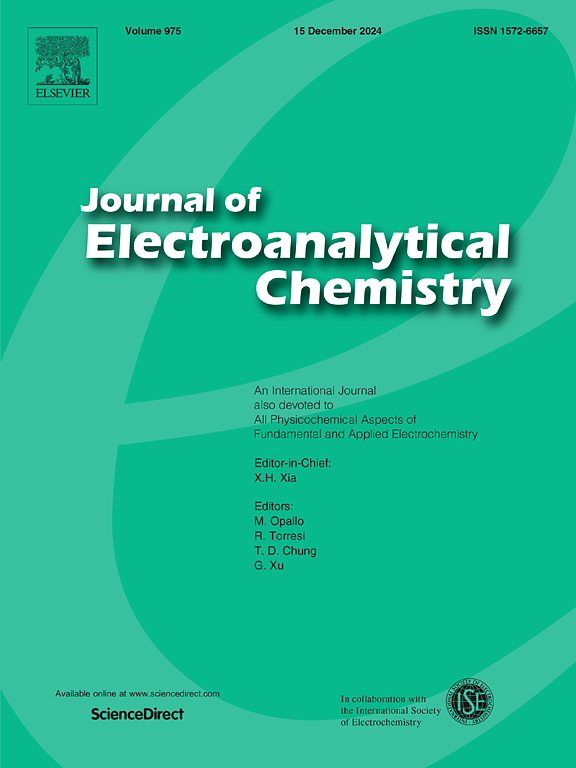Synthesis of TEMPO-containing EDOT derivative monomer and its polymer performance for electrocatalytic selective oxidation of HMF to DFF
IF 4.1
3区 化学
Q1 CHEMISTRY, ANALYTICAL
引用次数: 0
Abstract
A novel monomer 4-(4-((2,3-dihydrothieno[3,4-b][1,4]dioxin-2-yl)methoxy)butoxy)-2,2,6,6-tetramethylpiperidin-1-oxyl (EDOT-TEMPO) linked by ether bond was successfully synthesized. The corresponding conducting polymer PEDOT-TEMPO was prepared on platinum electrode via electropolymerization and characterized by SEM, EDS, element mapping and FTIR. PEDOT-TEMPO electrode showed high electrocatalytic performance for selective oxidation of 5-hydroxymethylfurfural (HMF) to 2,5-diformyl furan (DFF) in the presence of N-methylimidazole. Moreover, the electroactivity of PEDOT-TEMPO electrode was 85.3 % after consecutive scans of 100 cycles in 0.1 M TBAPF6/CH3CN solution. The electrochemical oxidation process of HMF on PEDOT-TEMPO electrode was investigated by in situ FITR spectroscopy and the possible reaction mechanism was proposed.
含tempo - EDOT衍生物单体的合成及其电催化选择性氧化HMF制DFF的聚合物性能
成功合成了一种新型醚键单体4-(4-((2,3-二氢噻吩[3,4-b][1,4]二恶英-2-基)甲氧基)丁氧基)-2,2,6,6-四甲基哌啶-1-氧基(EDOT-TEMPO)。通过电聚合在铂电极上制备了相应的导电聚合物PEDOT-TEMPO,并通过SEM、EDS、元素映射和FTIR对其进行了表征。在n -甲基咪唑存在下,PEDOT-TEMPO电极对5-羟甲基糠醛(HMF)选择性氧化为2,5-二甲酰呋喃(DFF)表现出良好的电催化性能。在0.1 M TBAPF6/CH3CN溶液中连续扫描100次后,PEDOT-TEMPO电极的电活性为85.3%。采用原位红外光谱法研究了HMF在PEDOT-TEMPO电极上的电化学氧化过程,并提出了可能的反应机理。
本文章由计算机程序翻译,如有差异,请以英文原文为准。
求助全文
约1分钟内获得全文
求助全文
来源期刊
CiteScore
7.80
自引率
6.70%
发文量
912
审稿时长
2.4 months
期刊介绍:
The Journal of Electroanalytical Chemistry is the foremost international journal devoted to the interdisciplinary subject of electrochemistry in all its aspects, theoretical as well as applied.
Electrochemistry is a wide ranging area that is in a state of continuous evolution. Rather than compiling a long list of topics covered by the Journal, the editors would like to draw particular attention to the key issues of novelty, topicality and quality. Papers should present new and interesting electrochemical science in a way that is accessible to the reader. The presentation and discussion should be at a level that is consistent with the international status of the Journal. Reports describing the application of well-established techniques to problems that are essentially technical will not be accepted. Similarly, papers that report observations but fail to provide adequate interpretation will be rejected by the Editors. Papers dealing with technical electrochemistry should be submitted to other specialist journals unless the authors can show that their work provides substantially new insights into electrochemical processes.

 求助内容:
求助内容: 应助结果提醒方式:
应助结果提醒方式:


